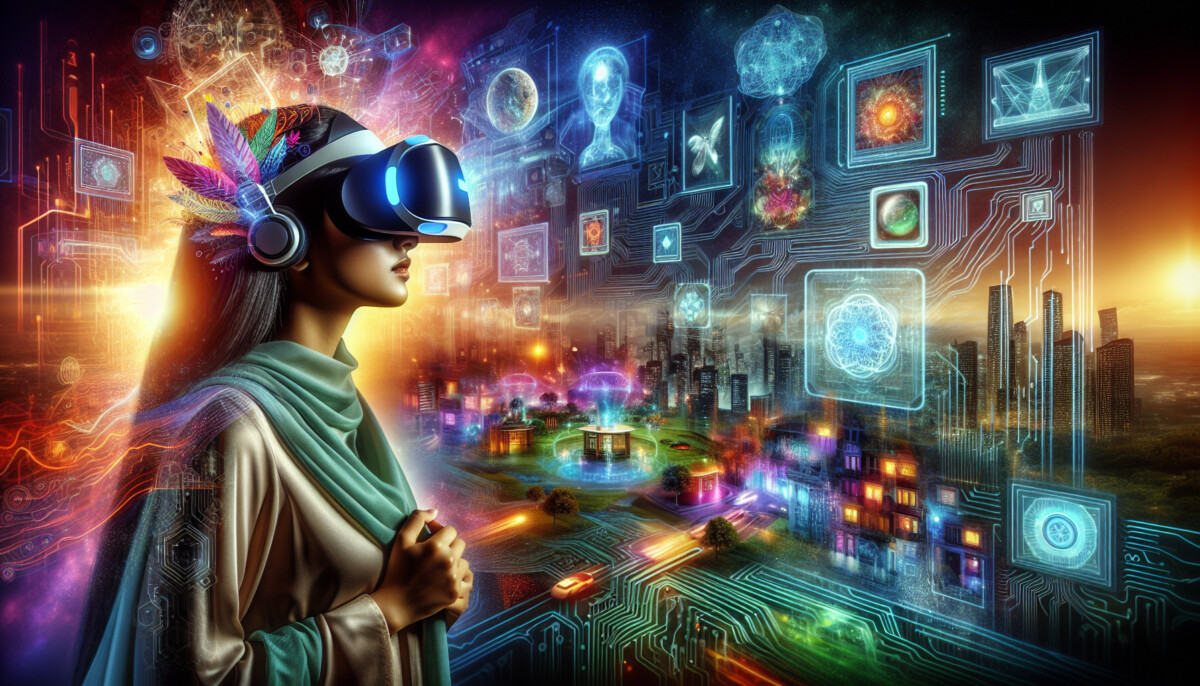User Tag List
Results 1 to 1 of 1
-
01-31-2025 #1Moderator


- Reputation
- 1
- Join Date
- Jul 2024
- Posts
- 2,678
- Thanks G/R
- 1/0
- Trade Feedback
- 0 (0%)
- Mentioned
- 0 Post(s)
- Tagged
- 0 Thread(s)
AI and the Metaverse: Merging Traditional and Blockchain Gaming
AI and the Metaverse: Merging Traditional and Blockchain Gaming

Introduction
The gaming industry has experienced a seismic shift over the past decade, driven by advances in artificial intelligence (AI), the rise of the metaverse, and the integration of blockchain technology. These innovations have transformed traditional gaming experiences, introducing decentralized economies, NFTs, and player-owned assets. As the metaverse continues to evolve, the convergence of AI, traditional gaming, and blockchain gaming is reshaping how players interact, compete, and monetize their digital experiences.
This blog explores the role of AI in the metaverse, the differences between traditional and blockchain gaming, and how AI-powered innovations are facilitating the fusion of these ecosystems.
The Role of AI in Gaming and the Metaverse
AI is at the heart of modern gaming, driving character behaviors, generating dynamic environments, and personalizing player experiences. In the metaverse, AI serves as the backbone for creating realistic interactions, automating governance, and optimizing economic structures. Here are some of the key applications of AI in gaming and the metaverse:
1. Intelligent NPCs (Non-Playable Characters)
AI-powered NPCs enhance gameplay by behaving more realistically and adapting to player actions. In both traditional and blockchain gaming, NPCs can simulate human-like interactions, making games more immersive. In the metaverse, AI-driven NPCs can function as virtual assistants, guides, or shopkeepers, facilitating transactions and enhancing the overall experience.
2. Procedural Content Generation
AI is used to generate game content, such as levels, quests, and environments, dynamically. This technology enables developers to create vast, ever-expanding worlds in both traditional and blockchain-based games. The metaverse benefits from AI-generated landscapes, reducing the need for manual development and ensuring a unique experience for each user.
3. Personalization and Adaptive Gameplay
Machine learning algorithms analyze player behavior to offer personalized recommendations, difficulty adjustments, and content suggestions. In blockchain gaming, AI-driven customization allows for dynamic NFT attributes, ensuring that digital assets evolve based on player engagement.
4. AI-Powered Economy Management
Blockchain gaming introduces decentralized economies where players can trade in-game assets as NFTs or cryptocurrencies. AI enhances these economies by predicting market trends, detecting fraud, and automating pricing mechanisms. AI-powered smart contracts can also regulate in-game transactions, ensuring fair and secure dealings.
5. Enhanced Security and Fraud Detection
AI helps secure traditional and blockchain games by identifying cheating behaviors, detecting unauthorized transactions, and preventing cyberattacks. In blockchain gaming, AI-driven security systems ensure the authenticity of NFT assets and prevent illicit transactions.
Traditional Gaming vs. Blockchain Gaming
Traditional gaming and blockchain gaming differ in several fundamental ways, from ownership structures to monetization models. However, both industries share common ground in gameplay mechanics, engagement strategies, and the use of AI.
Traditional Gaming
- Centralized Ownership: Game developers and publishers retain full control over game assets and economies.
- Microtransactions & Subscriptions: Players purchase in-game items, but they do not own them beyond the game’s ecosystem.
- Closed Ecosystem: Assets and progress are locked within individual games, preventing cross-platform use.
- AI-driven Experiences: AI enhances gameplay mechanics, storytelling, and adaptive difficulty.
Blockchain Gaming
- Decentralized Ownership: Players own in-game assets as NFTs and cryptocurrencies, allowing them to trade freely.
- Play-to-Earn (P2E) Model: Players can earn real-world value through gameplay.
- Interoperability: Blockchain enables cross-game asset transfers and metaverse integrations.
- Smart Contracts: Automate in-game transactions, ensuring fairness and transparency.
Despite these differences, AI is the bridge that can merge traditional and blockchain gaming into a unified metaverse experience.
How AI is Merging Traditional and Blockchain Gaming
As the gaming industry evolves, AI is playing a pivotal role in blending traditional and blockchain gaming elements. Here’s how AI facilitates this transformation:
1. AI-Driven Cross-Platform Compatibility
AI enhances interoperability by allowing assets and progress to be transferred across different gaming ecosystems. For example, AI algorithms can standardize NFT attributes, making them usable in both traditional and blockchain games.
2. AI-Enhanced Smart Contracts
AI can optimize smart contract execution by predicting market fluctuations, identifying fraudulent transactions, and automating dispute resolutions. This ensures fair and secure trading of in-game assets between traditional and blockchain gaming environments.
3. AI-Powered Virtual Assistants and NPCs
In both gaming models, AI-powered NPCs serve as game guides, traders, and interactive characters. These AI-driven entities can facilitate seamless transitions between traditional and blockchain gaming platforms within the metaverse.
4. Dynamic AI-Generated Game Content
AI-powered procedural generation ensures that both traditional and blockchain games can continuously evolve. This capability enables metaverse environments to remain engaging and immersive over time.
5. AI-Based Game Balancing and Fair Play
AI-driven analytics help maintain balanced gameplay by monitoring player behavior, adjusting game mechanics, and preventing pay-to-win models from dominating blockchain games. AI ensures that competitive gaming remains skill-based rather than financially driven.
6. AI-Backed Asset Authentication and Fraud Prevention
The integration of AI with blockchain can validate the authenticity of NFTs, preventing counterfeit digital assets from infiltrating the gaming market. AI-driven fraud detection systems safeguard players from scams and malicious activities.
The Future of AI, the Metaverse, and Gaming
The future of gaming in the metaverse is shaped by AI’s ability to harmonize traditional and blockchain gaming. As AI continues to advance, several key trends will define this transformation:
1. AI-Generated Metaverse Worlds
AI will automate the creation of vast, interconnected metaverse environments, ensuring that users experience unique worlds based on their preferences and interactions.
2. Decentralized AI-Powered Game Development
Blockchain-based decentralized AI models will allow community-driven game development, where players contribute to content creation, decision-making, and game governance.
3. AI-Enhanced Virtual Reality (VR) and Augmented Reality (AR)
AI will optimize immersive experiences in VR and AR-based metaverse games, improving realism, interaction depth, and real-time responsiveness.
4. AI-Driven Play-to-Earn Sustainability
AI will help regulate blockchain gaming economies, ensuring that P2E models remain viable and fair, preventing inflation and asset devaluation.
5. AI-Powered Cross-Metaverse Integration
Future metaverse ecosystems will allow players to move seamlessly between different virtual worlds, thanks to AI-driven interoperability solutions.
Conclusion
AI is revolutionizing gaming by merging traditional and blockchain gaming into a unified metaverse experience. Through intelligent NPCs, procedural content generation, adaptive gameplay, and AI-driven security, gaming is becoming more immersive, interactive, and economically viable for players worldwide. As AI continues to evolve, the synergy between traditional and blockchain gaming will shape the future of entertainment, ushering in a new era of decentralized and intelligent gaming ecosystems.
Similar Threads
-
How AI is Uniting Traditional and Blockchain Gaming for the Future
By Seithtanveer in forum CasinoReplies: 0Last Post: 01-31-2025, 04:16 AM -
AI in Gaming: Bridging the Gap Between Traditional and Blockchain Games
By Seithtanveer in forum CasinoReplies: 0Last Post: 01-31-2025, 03:59 AM -
AI and Blockchain: The Perfect Duo for a Balanced Play-to-Earn Economy
By Seithtanveer in forum CasinoReplies: 0Last Post: 01-30-2025, 06:11 AM -
The Synergy Between Decentralized AI and Blockchain Gaming
By Seithtanveer in forum CasinoReplies: 0Last Post: 01-27-2025, 06:35 AM -
The Next Frontier: AI and Blockchain in the Gaming World
By Seithtanveer in forum CasinoReplies: 0Last Post: 01-25-2025, 04:24 AM















 Reply With Quote
Reply With Quote







